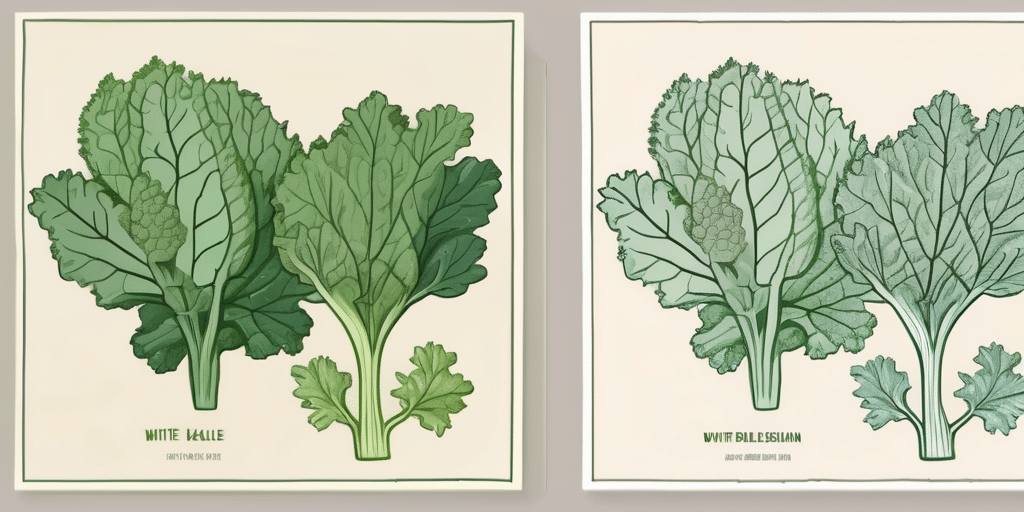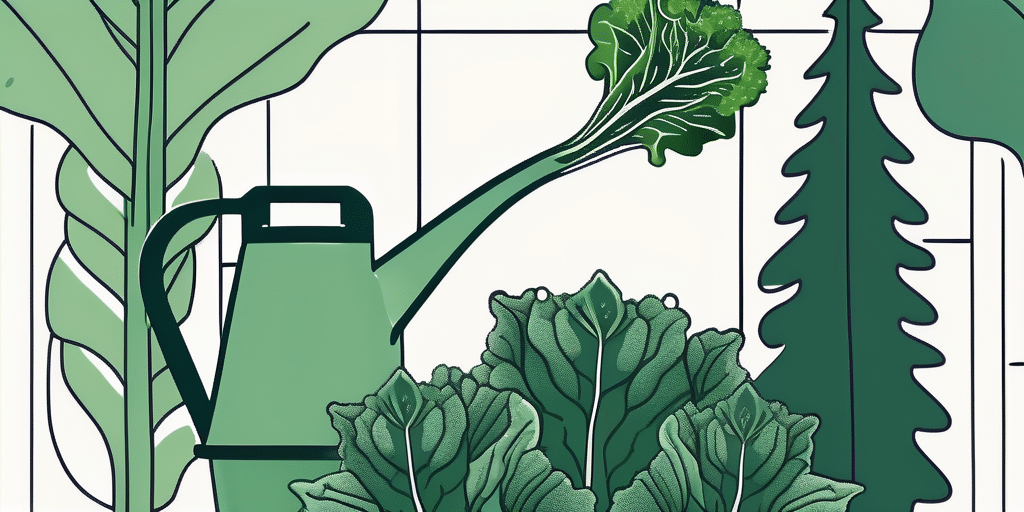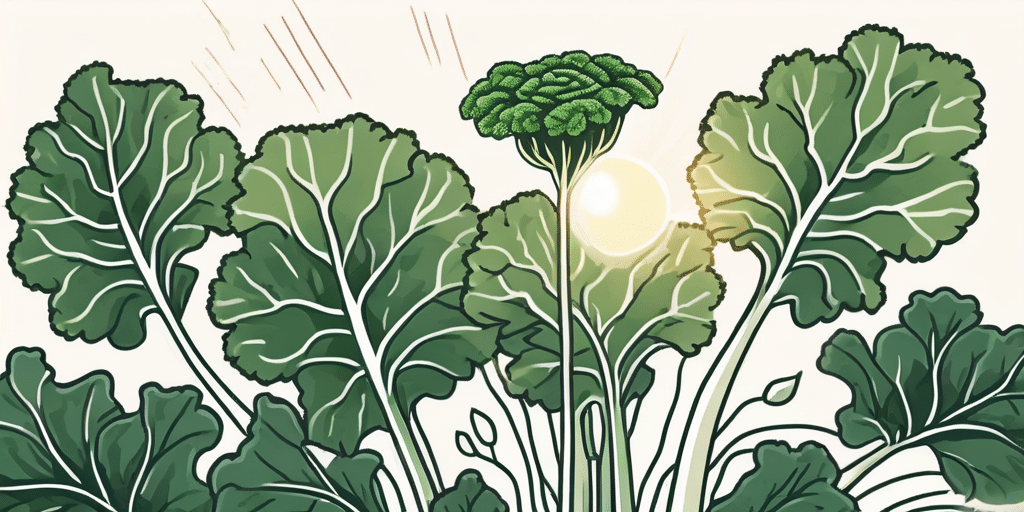In recent years, kale has become extremely popular due to its incredible health benefits. One particular variety that has gained attention is the White Russian Kale. Known for its tender leaves and mild flavor, this nutritious vegetable is a great addition to any garden. In this article, we will walk you through the step-by-step process of growing White Russian Kale and provide useful tips along the way.
When to Start White Russian Kale
Before getting started, it’s important to understand the ideal time to start growing White Russian Kale. This cool-season crop thrives in temperatures between 60-70°F (15-21°C). It can tolerate light frosts, making it an excellent choice for early spring or late fall planting.
How to Grow White Russian Kale From Seed
When growing White Russian Kale from seed, it’s essential to choose high-quality seeds. You can find them at local garden centers or online seed suppliers. Follow these steps:
- Select a well-draining location in your garden with full sun or partial shade.
- Prepare the soil by removing any weeds or debris. White Russian Kale prefers a slightly acidic soil with a pH of 5.5-6.8.
- Sow the seeds directly in the soil, spacing them ¼ to ½ inch (0.6-1.3 cm) apart, and cover them with a thin layer of soil.
- Water the seeds thoroughly, making sure the soil remains consistently moist but not waterlogged.
- Germination usually takes about 5-10 days. Once the seedlings reach a height of 2-3 inches (5-8 cm), thin them to a spacing of 8-12 inches (20-30 cm) apart.
By following these steps, you will ensure a healthy start for your White Russian Kale seedlings. Remember to be patient, as it takes time for them to establish themselves.
How and When to Transplant White Russian Kale
If you prefer to start your White Russian Kale indoors or want to speed up the process, you can start seeds in small pots or trays 4-6 weeks before the last expected frost date. Follow these steps:
- Fill a seed tray or small pots with a high-quality seed-starting mix. Moisten the mix before planting.
- Plant one seed per pot or cell, pressing it gently into the soil to ensure good seed-to-soil contact.
- Cover the tray or pots with a plastic dome or plastic wrap to create a greenhouse-like environment.
- Place the tray or pots in a warm location with indirect sunlight.
- After germination, remove the plastic cover, and provide ample light for the seedlings.
- When the seedlings develop their second set of true leaves, they are ready for transplanting.
- Harden off the seedlings by gradually exposing them to outdoor conditions for a week before transplanting.
- Transplant the seedlings into the garden, following the spacing guidelines mentioned earlier.
Transplanting White Russian Kale seedlings is a great alternative for gardeners who want to get a head start on the growing season and ensure a higher success rate.
How to Plant White Russian Kale – Spacing and Patterns
When it comes to planting White Russian Kale, proper spacing is crucial for the optimal growth and yield of the plants. Here are some guidelines:
- Planting in rows: Space your rows approximately 18-24 inches (45-60 cm) apart to allow sufficient airflow and easy access for harvesting.
- Within the rows: Space your White Russian Kale plants 12-18 inches (30-45 cm) apart. This spacing allows the plants to receive adequate sunlight and allows air circulation.
- Planting in patterns: For a visually appealing garden, consider planting White Russian Kale in a triangular or square pattern. This can also optimize the use of space in small gardens.
By following these spacing recommendations, you will provide enough room for each White Russian Kale plant to grow healthy and develop its full potential.
How Long to Grow White Russian Kale
The time it takes for White Russian Kale to reach maturity largely depends on the growing conditions and preferences of the gardener. However, on average, this variety takes about 50-70 days from transplanting to harvesting.
It’s important to note that White Russian Kale is a cut-and-come-again crop, meaning you can harvest the outer leaves as needed, and new leaves will continue to grow. This extended harvest period allows you to enjoy fresh kale for an extended time.
How to Water White Russian Kale
Proper watering is essential for the health and productivity of your White Russian Kale plants. Here are some watering tips:
- Consistency: Provide your kale plants with a consistent supply of water. Aim to provide approximately 1-1.5 inches (2.5-3.8 cm) of water per week.
- Avoid overwatering: Ensure that the soil is moist but not waterlogged. Overwatering can lead to root rot and other diseases.
- Deep watering: Water deeply, allowing the water to reach the roots of the plants. This encourages good root development.
- Mulching: Apply a layer of organic mulch, such as straw or wood chips, around the base of the plants. Mulching helps retain soil moisture and prevents weed growth.
Remember to monitor the moisture levels regularly and adjust your watering routine based on the weather conditions and the specific needs of your White Russian Kale plants.
How to Fertilize White Russian Kale
Providing proper nutrition is crucial for the healthy growth and development of your White Russian Kale plants. Here are some fertilization tips:
- Before planting: Prior to planting, amend the soil with organic matter, such as compost or well-rotted manure. This enriches the soil and provides a steady source of nutrients.
- Side dressing: Once the plants are established, side dress them with a balanced organic fertilizer, such as 10-10-10 or 14-14-14. Apply the fertilizer according to the package instructions.
- Compost tea: Occasionally, you can give your White Russian Kale plants a boost by applying compost tea. This natural fertilizer is rich in beneficial microorganisms and nutrients.
By providing the right amount of nutrients, you will promote vigorous growth and an abundant harvest of White Russian Kale.
Sunlight Requirements for White Russian Kale
White Russian Kale thrives in full sun or partial shade. It requires at least 5-6 hours of direct sunlight each day for optimal growth and leaf development. However, it can also tolerate some shade, making it suitable for planting in partially shaded areas of your garden.
When planning your garden layout, ensure that your White Russian Kale plants have access to sufficient sunlight to achieve the best results.
Soil Requirements for White Russian Kale
White Russian Kale prefers well-draining soil that is rich in organic matter. The pH of the soil should be slightly acidic, ranging from 5.5 to 6.8. A soil test kit can help determine the pH level. If necessary, you can adjust the pH by adding organic matter, such as compost or peat moss.
Prior to planting, it’s a good practice to prepare the soil by removing any weeds, rocks, or other debris. This creates a clean and fertile environment for your White Russian Kale plants to thrive.
How to Grow White Russian Kale Outdoors
White Russian Kale is well-suited for outdoor cultivation. Follow these steps to grow this nutritious vegetable outdoors:
- Choose a well-draining location that receives full sun or partial shade.
- Prepare the soil by removing any weeds, rocks, or other debris.
- Improve the soil by adding compost or well-rotted manure. Mix it thoroughly with the existing soil.
- Plant your White Russian Kale seeds or seedlings according to the spacing recommendations mentioned earlier.
- Water the plants thoroughly after planting, and continue to provide consistent moisture throughout the growing season.
- Monitor the plants regularly for pests and diseases. Tend to any issues promptly to prevent them from spreading.
- Harvest the outer leaves as needed, and enjoy fresh, flavorful White Russian Kale straight from your garden!
By following these steps, you can successfully grow White Russian Kale in your outdoor garden and enjoy the many health benefits it offers.
How to Grow White Russian Kale Indoors
If you have limited outdoor space or simply prefer indoor gardening, growing White Russian Kale indoors is a viable option. Here’s how:
- Select a suitable location with ample sunlight, like a windowsill or under grow lights.
- Choose a container with drainage holes that’s at least 6-8 inches (15-20 cm) deep to accommodate the root system.
- Fill the container with a high-quality potting soil mix. Moisten the soil before planting.
- Plant the White Russian Kale seeds or seedlings according to the spacing guidelines mentioned earlier.
- Place the container in a sunny location, ensuring that the plants receive at least 5-6 hours of direct sunlight each day.
- Water the plants when the top inch (2.5 cm) of soil feels dry. Avoid overwatering.
- Rotate the container every few days to prevent the plants from leaning towards the light source.
- Harvest the outer leaves as needed, and enjoy crisp and tender White Russian Kale grown right in your home!
Growing White Russian Kale indoors allows you to enjoy fresh greens year-round, regardless of the outdoor climate. It’s a convenient and rewarding way to incorporate this nutritious vegetable into your diet.
How to Grow White Russian Kale In Containers and Pots
If you have limited garden space or prefer the versatility of container gardening, growing White Russian Kale in pots or containers is an excellent choice. Here’s how:
- Choose a container or pot that has drainage holes and is at least 12 inches (30 cm) deep to accommodate the root system.
- Fill the container with a high-quality potting soil mix, leaving about an inch (2.5 cm) of space below the rim.
- Plant your White Russian Kale seeds or seedlings according to the spacing guidelines mentioned earlier.
- Place the container in a location that receives at least 5-6 hours of direct sunlight per day.
- Water the plants when the top inch (2.5 cm) of soil feels dry. Ensure that excess water drains out through the bottom holes.
- Fertilize the plants regularly with a balanced organic fertilizer to promote healthy growth.
- Monitor the plants for pests and diseases, and take appropriate measures to address any issues.
- Harvest the outer leaves as needed, and savor the crisp and flavorful White Russian Kale grown in your own container garden!
Growing White Russian Kale in containers offers flexibility and convenience. It allows you to move the pots around to take advantage of the best sunlight and accommodate changing garden layouts.
White Russian Kale Companion Plants – What to Plant With & Not Plant With White Russian Kale
Companion planting is a valuable technique that involves planting mutually beneficial crops together. Some plants can help repel pests, attract pollinators, or improve soil quality when grown alongside White Russian Kale. Here are some companion plants that work well with White Russian Kale:
- Carrots: Carrots and White Russian Kale make excellent companions. Carrots help break up the soil and attract beneficial insects, while kale can provide some shade and protection from the intense sun.
- Mint: Mint can repel aphids and other pests that may attack White Russian Kale. However, it’s important to plant mint in containers or use barriers to prevent it from spreading and becoming invasive.
- Lettuce: Lettuce can be interplanted with White Russian Kale. It can provide shade and keep the soil moist, benefiting both plants.
- Beans: Beans act as atmospheric nitrogen-fixing plants, enriching the soil with this essential nutrient. They can improve the overall health of White Russian Kale.
While companion planting can provide numerous benefits, some plants may not thrive when grown alongside White Russian Kale. Avoid planting kale near members of the cabbage family or other cruciferous vegetables, as they can be susceptible to similar pests and diseases.
Common White Russian Kale Pests and Diseases
While White Russian Kale is generally resistant to pests and diseases, it can still face some challenges. Here are a few common issues to be aware of:
- Aphids: These tiny insects feed on the sap of kale leaves, often causing them to curl and turn yellow. Spray a strong jet of water or use insecticidal soap to control aphid infestations.
- Cabbage loopers: These green caterpillars can chew holes in kale leaves. Physically remove them from the plants or use organic insecticides labeled for caterpillar control.
- Whiteflies: Whiteflies are small, white insects that feed on the undersides of kale leaves. They can be controlled with insecticidal soap or by introducing natural enemies like ladybugs or lacewings.
- Downy mildew: This fungal disease causes yellowing and wilting of kale leaves. To prevent downy mildew, ensure proper air circulation, avoid overwatering, and promptly remove any infected leaves.
- Clubroot: Clubroot is a soil-borne disease that affects the roots of kale plants, causing stunted growth and wilting. Practice crop rotation and avoid planting cruciferous vegetables in affected areas.
Regularly monitoring your White Russian Kale plants and taking preventive measures can help minimize the impact of pests and diseases. If necessary, consult with your local agricultural extension office for specific pest control recommendations.
How & When to Harvest White Russian Kale
Harvesting White Russian Kale is an exciting moment for any gardener. Here’s how to harvest your kale leaves while ensuring the ongoing growth of the plant:
- Wait until the White Russian Kale plants have reached a height of 10-12 inches (25-30 cm), which usually takes about 50-70 days from transplanting.
- Starting from the bottom, select the outer leaves that are approximately 6-8 inches (15-20 cm) long.
- Using a sharp knife or scissors, cut the leaves at the base, leaving the central growing point intact.
- Continue harvesting the outer leaves as needed, allowing the inner leaves to continue growing.
- For a continuous harvest, avoid removing more than one-third of the plant’s leaves at a time.
Regularly harvesting the outer leaves of your White Russian Kale plants will encourage new growth and prolong the harvest period. Enjoy your freshly harvested kale in salads, smoothies, stir-fries, or any other way you like!
How to Store & Preserve White Russian Kale
Proper storage and preservation techniques can ensure that your White Russian Kale stays fresh and flavorful for an extended period. Here’s how to store and preserve your kale:
- Refrigeration: Place freshly harvested kale leaves in a plastic bag or airtight container and store them in the refrigerator’s crisper drawer. They should stay fresh for up to a week.
- Freezing: Blanching kale before freezing helps retain its color, texture, and nutritional value. Here’s how:
- Wash the kale leaves thoroughly and remove the tough stems.
- Bring a large pot of water to a boil and prepare an ice bath by filling a large bowl with water and ice.
- Place the kale leaves in the boiling water and blanch them for 2-3 minutes.
- Using a slotted spoon or tongs, transfer the blanched kale leaves to the ice bath to cool rapidly.
- Drain the kale leaves thoroughly and place them in airtight freezer bags or containers.
- Label the bags or containers with the date and freeze the kale for up to 12 months.
- Dehydrating: Dehydrating kale allows for long-term storage and makes it a versatile ingredient. Here’s how to dehydrate kale:
- Rinse the kale leaves thoroughly and pat them dry with a clean towel.
- Remove the tough stems, and tear the leaves into bite-sized pieces.
- Arrange the kale pieces on dehydrator trays, making sure they don’t overlap.
- Set the dehydrator temperature to 115°F (46°C) and let it run for 8-10 hours, or until the kale becomes crispy.
- Store the dehydrated kale in airtight containers away from heat and moisture. It can last for several months.
By applying these storage and preservation methods, you can enjoy the goodness of White Russian Kale long after the growing season has ended.
Frequently Asked Questions
Here are some answers to commonly asked questions about growing White Russian Kale:
- Q: Can I grow White Russian Kale in containers on a balcony?
- A: Absolutely! White Russian Kale is well-suited for container gardening, making it a perfect choice for balconies or small spaces.
- Q: Can I interplant White Russian Kale with other vegetables in my garden?
- A: Yes, White Russian Kale can be interplanted with various vegetables. Consider companion planting with carrots, lettuce, or beans for mutually beneficial relationships.
- Q: How often should I fertilize White Russian Kale?
- A: Side dress White Russian Kale with a balanced organic fertilizer every 4-6 weeks throughout the growing season.
- Q: Can I save White Russian Kale seeds for future planting?
- A: Yes, you can save seeds from White Russian Kale. Allow a few plants to bolt (produce flowers) and go to seed. Harvest the dried seed pods and store them in a cool, dry place for future use.
- Q: What are some delicious ways to enjoy White Russian Kale?
- A: White Russian Kale can be enjoyed in a variety of ways. Some popular options include adding it to salads, making kale chips, blending it into smoothies, or sautéing it with garlic and olive oil. Get creative and experiment with different recipes!
We hope this comprehensive guide on how to grow White Russian Kale has inspired you to give it a try. With proper care, you’ll be rewarded with a bountiful harvest of this nutritious and versatile vegetable. Get your hands dirty, embrace the joy of gardening, and savor the taste of homegrown White Russian Kale!
Join the How to Grow Everything Community
Ready to transform your green space into the garden of your dreams? Subscribe for free to How to Grow Everything and gain access to personalized gardening advice tailored to your location, grow zone, and experience level. Dive into our extensive library of gardening articles, enjoy special offers, and receive the best gardening tips straight to your inbox. Join our family of garden enthusiasts and start building your dream garden today—100% free, no spam, just pure gardening gold.






